First Looks at Merlin
Unless you have been living under a rock for the past few months (or have been using Microsoft products), you couldn't help but hearing about IBM's worst-kept secret: Merlin. Merlin is IBM's code name for the next release of OS/2, and the editors of WarpOnline got a chance to take a look at the first beta release of the operating system. We were impressed from the minute we ripped open the padded mail envelope, and got straight to work preparing a summary overview for you.
IBM started the beta process in May, 1996 with an registration program that appropriately was on an Internet page. Unfortunately, thousands of excited potential beta recipients were disappointed when IBM mailed out only about 20,000 copies to outside users - a number much less than the number of people wanting to give it a try. IBM may soon have another beta round - this one ends officially on July 22 - so don't be sure you are out of the running yet if you didn't get a copy this time.
Our test machine was an IBM ThinkPad 755CDV, which is a 486DX4-100 processor with a double-spin CDROM and SVGA graphics. Our system had 20 megabytes of RAM and an 810MB hard disk. IBM's official minimum requirement for using the Voice system built into Merlin is a 90Mhz Pentium system - and the installation procedure warns you if your machine isn't up to snuff.
The installation went incredibly smoothly. From the start, we enabled TCP/IP and NETBIOS networking support, OpenDoc, VoiceType, the Java Development Kit, the new BonusPak including IBM Works, Video In, HyperAccess, FaxWorks and the CompuServe Information Manager. While we haven't had time to try all of the BonusPak, IBM says that they have made substantial improvements to almost everything in the pack. The installation process is now integrated - there is no separate networking install as in Warp Connect, nor do you need to install the BonusPak separately - they are all together on one CD and can be installed and de-installed using the same program.
There is a second CD in the package that is a truly amazing compilation of support and driver information for OS/2. Every company that provides OS/2 support and drivers for their products is listed on this CD, as well as hot-links to Internet addresses, telephone support numbers, and in many cases, the drivers themselves. The package is accessed using the WebExplorer or any web browser, and proves that the driver problems OS/2 had in the past are now behind it.

The installation took about 25 minutes from CD, and the system rebooted 3 times normally during the process - the first time to bring up a reduced-function shell of the OS, the second time after all of the multimedia and network drivers were loaded, and the third to bring up the final finished operating system. We had no errors, and after installing the MWave sound drivers (the same ones that were used with Warp), the system install was complete.
One of the first things you notice about the system is its striking appearance: IBM has put a lot of work into improving the icons, fonts and other system appearance factors. In fact, IBM hired the designer of the original Macintosh and Windows icons and objects to revamp the Warp items - and the money shows. The system now sports a new font called WarpSans which is used by default for all title bars and icon labels. It was originally designed to be more visible on laptop computers than the previous system font - and those of OS/2's primary competitor. Also, Merlin now supports TrueType fonts - opening up a vast library of new choices to the OS/2 user.
The WarpCenter
On the top of the screen is the most important change to the OS/2 user interface - the WarpCenter. Drawn heavily from the Lotus SmartCenter that came with the OS/2 SmartSuite 2.1, the WarpCenter brings together all of the functions of your system into one easy-to-configure bar. It would be easy to confuse this with the Windows 95 TaskBar, but they are strikingly different.

For example, the WarpCenter does not show your current running programs - but it allows you to drag and drop icons onto the bar into "trays", much like the drawers on the old LaunchPad in Warp. The trays can be renamed, and with one click you can change the set of icons displayed on the WarpCenter between different trays. There are also buttons on the bar for shutdown, find and lockup, a section that switches with a click between the current time, the date and a stopwatch, as well as another section that changes between a CPU monitor, a battery level meter and a free hard drive space meter. Another button shows a popup menu that displays all of your running tasks.
The leftmost section of the bar is a cascading menu that mirrors the layout of your desktop. For example, if you have an OS/2 System icon on your desktop, that will show up as a first-level menu option when you click this OS/2 Warp button, and contents of each folder within the OS/2 System folder will be displayed as cascading menus. The WarpCenter can be placed on the top or bottom of the screen, and there is a setting for automatically hiding it until the mouse is moved over the WarpCenter's position. Popup help labels appear if your mouse lingers over a button for a few seconds. All in all, a much more intuitive and customizable function than the Windows 95 TaskBar, which is of course typical for OS/2.
Other Interface Changes
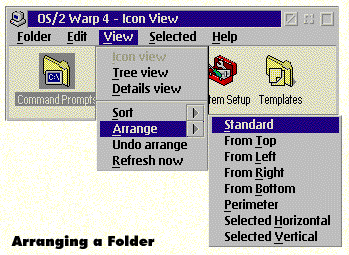
The rest of the system has also undergone a facelift. Every folder in the system now has a menu bar on it to allow you to easily access functions that were only previously available under the right-click popup menu for the folder. For example, you can now access folder properties, sort and arrange the icons, and also access options for any selected items in the folder from the menu. There are several new arranging options as well, including the ability to sort icons into a grid pattern, or align a selected group of icons vertically or horizontally or spread them around the perimeter of a folder. The last three options are especially handy for rearranging your desktop. Speaking of that - now any object can be set to ignore any commands to "arrange" - ending the accidental re-arrangement of your desktop forever.
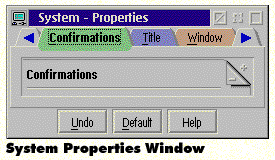
When you open a properties window (formerly called the settings notebook), the changes are evident immediately. Now all of the tabs for the notebook run horizontally across the top, and can be scrolled left or right to view them all. They are now colored and some of the names of standard tabs have been changed to better reflect what they allow you to change. Right-clicking on the tabs will bring up a popup menu that lets you jump quickly to the option you are looking for.
There are a lot of new system settings as well, including full window drag, which moves the whole graphic of the window when dragged, not just an outline.
One of the neatest new features is called Asyncronous Focus Transfer. Actually introduced in the OS/2 Warp FixPack 17, this allows the system to "grab control" away from a stalled application and pass it to the next one when you depress ALT-F2. That way, you don't have to wait for the system to discover a program has crashed before letting you close it - you can just switch away, bring up the task list, and close it quickly.
The Assistance Center
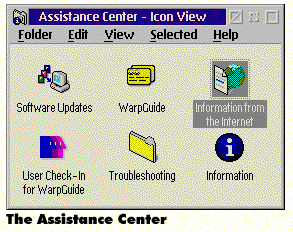
IBM has also done a lot to assist the new user of OS/2 in learning how to exploit the features of the operating system. One of those new additions is an icon on the desktop called the Assistance Center. Inside you will find all kinds of resources to help you learn about OS/2, including links to resources on the internet. Another new feature is called the WarpGuide. If you need help with a system function, for example, adding a printer, the WarpGuide will help you with step-by-step instructions on how to accomplish your task.
At other times the WarpGuide will pop up context-sensitive CueCards to help you learn a new function. You can register yourself with the WarpGuide and choose one of three proficiency levels, and the WarpCenter will tailor the CueCards to your needs.
There is another icon in the Assistance Center titled "Software Updates". Double-clicking this yields a connection to an Internet page that is not available yet. It would appear that IBM is working on a system to update your OS/2 operating system over the Internet, much like you could with the Internet Access Kit in OS/2 Warp. That would be VERY interesting, and hopefully it will make it to the final cut.
Making Connections
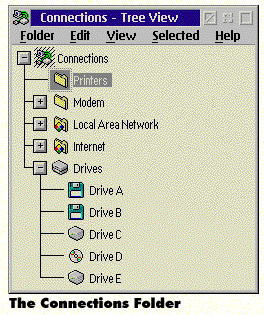
Also new to Merlin is the Connections folder on the desktop. Inside you will find everything that you are "connected" to - including drives, network resources, Internet sites and even printers. Included with Merlin is the complete TCP/IP stack, including the dialer and WebExplorer, much like the old BonusPak.
For network users, the File and Print Client Browser allows you to take a quick look at all of the servers on your network, and make connections and use resources with just a few clicks. For example, you can shadow a file or a drive on a network server to your desktop, and the next time you open that file, if you are not connected to the resource OS/2 will automatically reconnect you to the server to access the file or drive. The same holds true for Internet resources as well - double click a URL and the WebExplorer will launch to connect you to that site - as well as detect if you need to start the dialer before you can get there.
Speaking of Internet improvements - the WebExplorer is now integrated much more tightly with the interface. You can now store URLs in folders and double-click them to connect, as well as drag open URLs to folders or to the desktop and adjust settings for each one. IBM even gives you a folder full of sites to check out - and even WarpOnline is on the list.
Even with this improvement, the WebExplorer is still fundamentally the same program we have always had - as well as the rest of the Internet kit. Much of the promised integration of the Internet into the system has not yet materialized. The WebExplorer isn't even the Java version yet - when you select Java installation, all you get is the Java Development Kit, which is good for little more than running the small demo "craplets" that come with the kit, unless you are a Java programmer. This part is the weakest part with Merlin, and it needs to be brought up to industry-standard levels.
"Computer: Listen To Me"
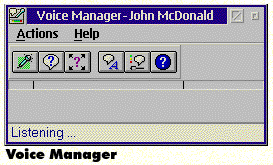
The most exciting new feature of Merlin has to be the integration of IBM's VoiceType technology into the base operating system. This is a true example of world-leading technology brought to the desktop. Much more than just a direct port of the VoiceType product, the Merlin version now will use any MultiMedia Presentation Manager-enabled sound card - so if your sound works on Warp, you can use it for voice.
This new version also very good at understanding your voice without training. In the past, you had to sit down and record hundreds of words to teach VoiceType how you talk. While you can still do this - and training vastly improves accuracy with each phrase you record - out of the box we were able to navigate the system with only a couple of misunderstood words - even on a 486.
The first requirement is a good microphone - and IBM has been rumored to be considering including a high-quality ambient noise canceling headset in the Merlin package when it ships. We were supplied with a pre-release version of just such a microphone, and using it really increases the accuracy of the system. We were able to navigate the system quite easily using short phrases, such as "Window List", "Down", "Open" or "Desktop".
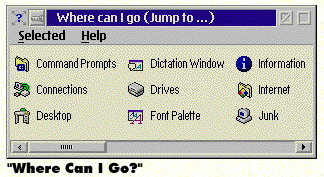
However, the real power comes when you start to record Jump Words and Voice Macros. Jump words are just voice tags that you can attach to any object in Merlin, and with a quick "Jump To ..." you will launch that program, open that data file, or open that folder. By saying "Where Can I Go" a window will open up showing you all of your Jump locations.
A Voice Macro lets you record keystrokes and pauses for a particular application and launch them with a voice command. For example, lets say you have a printer on the 2nd floor of your building and you have to execute a series of menu commands to select that printer and print the current document to it in your favorite word processor. Now, you can record those keystrokes and by saying a phrase like "Print this on the 2nd floor", those keystrokes will be played back instantly.
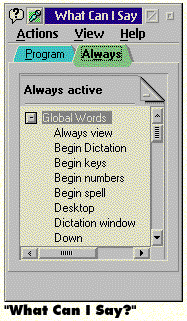
IBM has extended the Workplace Shell to include these Voice Macros and Jump Words, so every single program and data file has a "Voice" tab in its properties window. Even old OS/2 applications and Windows data files can have voice tags assigned to them - it is a complete integration. As you move around the desktop using voice commands, the window, menu bar or control that currently has your voice's "focus" will be highlighted with a blue box around it. This way you know where you are talking to: if the blue box surrounds a check box, saying "On" will turn the checkbox on. A window called What Can I Say can show you your valid word choices at any time. You don't need to have any windows showing at all - the title bar of your currently opened window will change its text to show you when your command has been understood or not.
The other half of the Merlin Voice functions is the Dictation Window. By saying "Start Dictation" while your cursor is on any text field, including word processors, you will pop-up a window that will take dictation and recognize each word as you say it. This is the part that requires a Pentium 90 processor to not be frustratingly slow, but even with our 486 we were able to get a taste of what it can do. It was quite accurate even without training, and if it makes a mistake, simple voice commands will correct it. When you say "Stop Dictation" the window closes and pastes your dictated words where your cursor was located when you opened the window.
Final Thoughts
It is clear that there has been many hours and a lot of money spent on improving OS/2. The new user interface changes promise to once again make OS/2 the best looking operating system, and will make great strides in making it easier to use and to understand. The Voice integration is a true world-pacesetter, and brings a function to OS/2 that no other operating system has. Adding improved stability, a wide range of included applications and utilities, and once again OS/2 promises to be the world standard.
The stability is remarkable for a beta - we have only had to reboot once and that was probably due to a network error and not to Merlin. We have yet to find an application or driver that doesn't work with it, meaning a quick and painless upgrade for most users.
The most disturbing thing about the beta is a lack of true improvement in the Internet tools. The WebExplorer has only been improved in minor ways - a new "Links" menus displays all of the links on the currently viewed page under a pull-down menu - probably to make voice navigation of the Web possible. However, massive problems still exist, including the inability to sort or edit items in the QuickList. It is clear that the designers would like you to use folders full of URLs to drag and drop on the Explorer, but while surfing this is cumbersome. We were never able to use the dialer to make a successful dialup connection to an independent Internet service provider, as the internal TCP/IP settings for our in-office network kept getting in the way. Finally, there is a wholesale lack of improvements to ANY of the other internet tools - in fact, it would seem that they have all been moved onto the beta CD completely unchanged.
It is clear that there will be much improvement over the next few months until Merlin finally ships, so we hold out hope that the Internet integration will once again be world-class. The old tools have aged - and new ones need to take their place.
OS/2 is alive and well - and we are excited about what we see. With Merlin, OS/2 Warp will once again take its place as the gold standard of operating systems, and you will be there when it happens.

